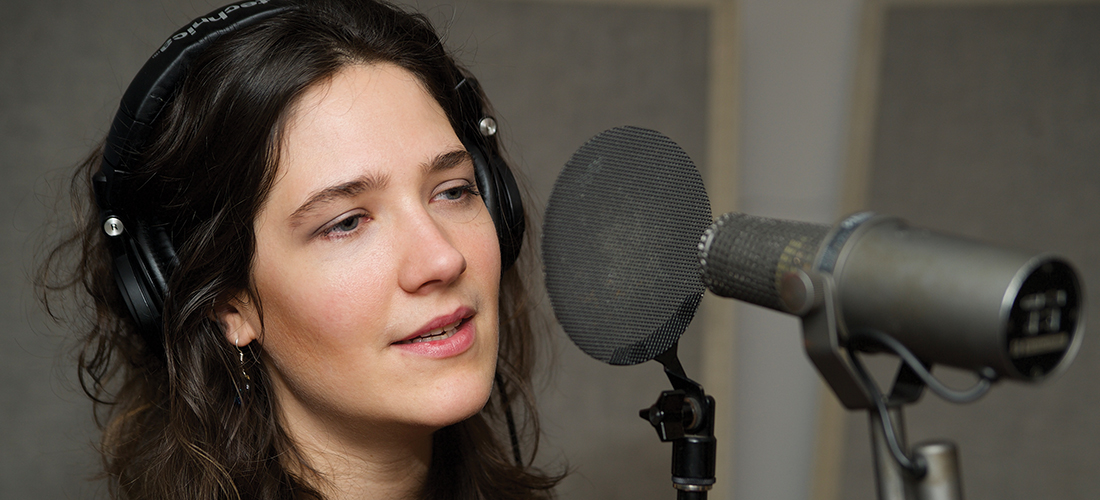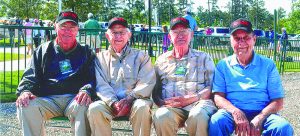
Behind the Music
Anne-Claire Niver travels at the speed of sound at Mitch Easter’s Fidelitorium
By Grant Britt
It’s a jungle in here. Wires and cords snake across the floor in a maze, ready to trip up interlopers or careless participants. Hulking shapes loom in the shadows, some shrouded in camouflage, others proudly displaying their steely visages. A soundtrack gradually fades in, some exotic species offering up snatches of melody. A coterie of humans slink in one at a time, moving soundlessly to the rhythms.
Local chanteuse at O.Henry Hotel’s jazz concerts Anne-Claire Niver and her band are ensconced in Mitch Easter’s Fidelitorium in Kernersville, working on their latest, album, I Still Look For You (for a sampling, visit www.youtube.com/watch?v=TsS-TtPLsEg). Mitch Easter, owner/founder of the Drive-In Studio — which launched a number of indie-rock acts, R.E.M., Let’s Active, the Connells and Suzanne Vega in the 1980s and early ’90s — carries on the tradition with another generation via Social Media.
“Three-hundred people donated, helped us out on Kickstarter, so everybody’s getting paid,” Niver says happily.
The studio is like a funky church with a fluid 1970s vibe that blurs at the edges, shape-shifting back and forth from past to present, a mix of technologies and trappings giving time a slippery feel. In a silent parody of the old RCA logo of a terrier with his nose in the bell of a gramophone, a huge, ancient trumpet-belled speaker sits high on a ledge next to a carved wooden peacock — or maybe it’s just a big duck with its bill in the bell. There are no clocks in evidence; time is suspended and fluid.
“Some of the stuff that’s in there is stuff that I bought when I first ever started doing this,” Easter says by phone from the road, where he’s playing guitar with Alejandro Escovedo on his A Man under The Influence tour. “Some of it is only used about once every two years. But when somebody comes in and wants to use that thing, then they use the hell out of it and really enjoy it,” he says, underscoring his willingness to blend past and future technology to help musicians achieve their goals.
We have a few things you might say would be bit squeaky because of their age, but people actually enjoy that now, as compared to the sort of predictability.”
But as he is quick to point out, it’s not just the equipment that makes the sound, but how you use it. “We don’t make any grand claims about superiority or state of the art or anything like that,” Easter says. “But what we think is that it works.”
And on this morning, it seems to be working for Niver and crew, as the playback rolls on one of their new songs, “Mosquitos,” while band members stroll in and out of the control room, bobbing to the beat. Producer/bassist Alex Bingham is playing air bass and conducting to an invisible audience as Angela Davis looks on from the back wall, her puffy Afro gleaming under a purple DayGlo light.
In the control room, lava lamps minus the lava flank a neon blue leather couch facing a mixing console that looks like the flight deck of the starship Enterprise. A ceramic Balinese dog with bundles of patch cords hanging from its open jaws guards one corner of the control room while Mabel, producer/bassist Bingham’s real-life dog, growls at anyone who dares cross the threshold.
From the outside, Fidelitorium certainly doesn’t look like a recording studio. A steel fence and a stand of bamboo help shield it from curious onlookers. The entrance to the long, winding driveway is flanked by gnarled wooden sentinels so grooved with vine scars and decades of hard living they look more like sculptures than living trees. It looks like concrete block, but more upscale, like something Frank Lloyd Wright might have envisioned.
The guiding force behind the design, Chapel Hill–based Studio designer Wes Lachot, is a Wright devotee, using some of architect’s design concepts blended with current sound innovations in building materials. Instead of concrete blocks, he implemented DiffusorBlox, concrete masonry blocks built for sound isolation. Wavy on one side, they stretch to the ceiling on the rear control room wall and side walls of the main live room. It’s a very warm-sounding space, the remaining area swathed in blonde birch.
It creates a womblike environment for Niver, ensconced in an isolation booth blocked off from the control room window with several screens including an Asian panel screen. “Alex did it,” Niver says, “covered up the window so it wouldn’t psych me out.” It’s not that unusual for performers. Jimi Hendrix was also reportedly skittish about prying control room eyes and had access blocked, as well.
Having produced records for so many artists over the years, Easter understands the importance of a workspace conducive to the creative process. “Home office, work from your bedroom — that can be good, it can also sort of not work. It’s also important to get up in the morning, put on a coat and go somewhere. Then you’ll actually be in the right frame of mind to work,” he says.
Today, the band is working on overdubs for “Behind Me,” the last song Niver wrote for her yet-untitled second studio album. Niver is fist-pumping on the chorus, puttering softly with low key scat outbursts before sliding back into the upper register. The melody is shot through with flecks of soul, an upbeat chronicle of recovery from the loss of a loved one, her grandmother, Willa Bullock. “I don’t fight so hard/as I did/I don’t cry quite as much/ Like I did. . ./ I stand alone my doubts behind me,” she sings softly, but with a steely resolve.
Inside the isolation/vocal booth, Niver has erected a small shrine. Atop a small black Roland amp, a candle flickers between two small framed pictures propped up against the wall. One picture is of grandmother Bullock, who passed away about a year and half ago. (A single, “Willa,” from the new album, is about her grandmother, as well a couple of songs about that loss. “She was very musical, always singing in the house,” Niver says.) The second photo is a postcard of Beethoven’s birthplace in Bonn, Germany. “I was in my second-grade classroom, we were having some sort of free time, and my teacher had the classical station on. I was playing and listening to the classical station and I turned to my teacher and I said, ‘This is Beethoven, by the way,’” Niver recalls. She was already familiar with the longhairs because her grandparents listened to Raleigh classic radio station WCPE. Ever since her second-grade music teacher sent it, the postcard has been a constant companion. “It’s traveled all over the world, been to Thailand and back.”
Niver and her band — lead guitarist Ryan Johnson, rhythm guitarist David Dollar, keyboardist Charles Cleaver, drummer Daniel Faust and bassist/producer Bingham — are leasing the studio for a week, then tinkering with the mix before and afterwards at their home studio in Durham, mirroring a trend among working musicians that Easter is willing to accommodate. “Some people that have worked in our place did record in their house and realized that it just didn’t suit them,” the producer notes. So he’s established another perk: providing a separate guesthouse for the bands to use. “I always loved the English residential studios,” he says. “England has always had the theme of studios in the same spirit of people liking to go to a dedicated place for work, to be at a compound or retreat. Even though we’re not in the Tuscan countryside, it still functions like that, and a lot of people just like to be on the premises. Also nobody’s got any money anymore, so that makes the whole thing more affordable. We don’t charge anything extra for the house.”
Easter’s low-key approach seems incongruous with the studio’s hifalutin name, a tongue-in-cheek throwback to some pretentious overachievers’ clumsy studio names of yore. “I think it was due to the owners’ total lack of knowledge of Latin, like audio phonics, which is like naming your studio ‘sound sound,’” Easter muses. Appreciating the gravitas of Latin as well as bland studio names “like Sound Recording Service,” Easter came up with the idea of using faux Latin, hence the name, Fidelitorium, an amalgam of the Latin root for “fidelity,” as in “high fidelity” and the tail end of “auditorium.” “[It] was like calling it Studio, a word for studio, so studio is for recording, so the name of the place is studio recording. Which is as generic as I could think of. Then I thought, I’ll make it Latin, because, why not?” Classical scholars may note that Easter’s fractured Latin does not translate perfectly, but musicians understand that while he may joke about the name, the studio is serious business.
Whatever you call it, for Niver and her band as well as scores of local regional and national artists, the Fidelitorium is the place to put the polish on your sound or build it from the ground up.
“Our place is really practical,” Easter affirms. “It’s not meant to be cute or anything. Some people think the old equipment is kind of kitsch whimsy, but it’s really not, it’s part of what you use to make recordings these days, along with some more predictable and modern things. That’s what we try to do, we try to just have stuff that will truly help people make their records.” OH
From his home studio across from the graveyard, Grant Britt makes sounds only dogs can hear, a rare courtesy for which his neighbors are eternally grateful.





